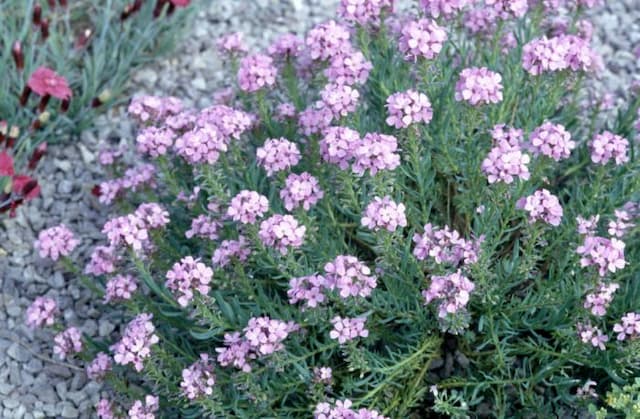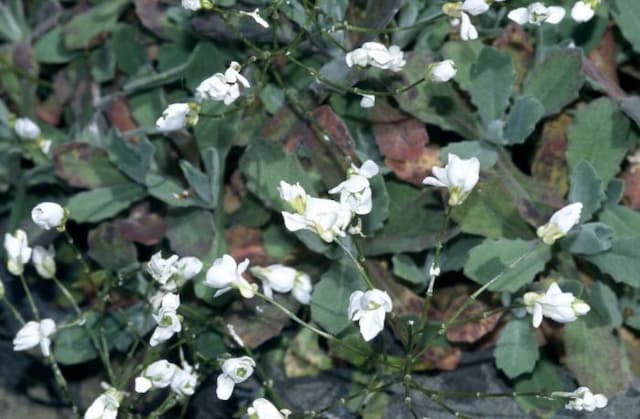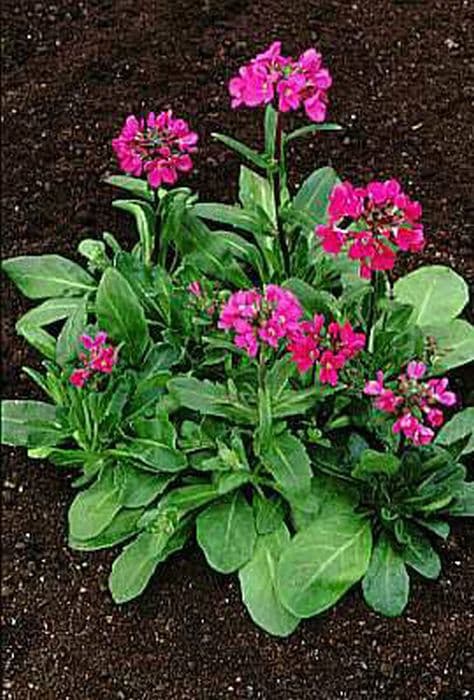Spiny cushion Hormathophylla spinosa 'Roseum'

ABOUT
Hormathophylla spinosa 'Roseum', often known as the spiny holdback, is a striking plant that exudes a unique aesthetic with its distinctive features. This plant is characterized by a dense, mat-forming growth habit that effectively creates a ground cover. The leaves of the spiny holdback are small, conical, and exhibit a mesmerizing blue-green hue. These spiny leaves are arranged in rosettes, which contribute to its cushion-like appearance. The spiny holdback blooms with enchanting flowers that burst into color during its flowering season. These flowers are a delightful shade of pink, which forms a vivid contrast against the blue-green foliage. The petals are delicate and arrayed in a clustered formation at the end of short flowering stalks that rise modestly above the foliage. These attractive clusters make for a spectacular floral display. It is the thorny aspect of the leaves that defines the 'spiny' nature mentioned in its common name—spiny holdback. This defensive attribute not only adds to the texture but also serves as a point of interest for both gardeners and passersby alike. The overall posture of the plant is low-lying and spreading, with a tendency to create a full, plush mat over the ground it occupies. Its hardy demeanor and rich floral coloration make it a prized addition to rock gardens, alpine displays, or as an ornamental feature in diverse garden settings.
About this plant
 Names
NamesFamily
Brassicaceae.
Synonyms
Spiny Hormathophylla, Pink Cushion.
Common names
Pritzelago alpina subsp. spinosa, Horminum spinosum, Hutchinsia alpina var. spinosa, Aethionema spinosum, Aethionema saxatile var. spinosum.
 Toxicity
ToxicityTo humans
Hormathophylla spinosa 'Roseum', commonly known as the spinose rock-cress, does not have a well-documented profile of toxicity towards humans. However, the absence of clear toxicity information suggests that caution should be exercised, as with any plant not commonly consumed. If a person ingests part of the plant and experiences symptoms such as nausea, vomiting, abdominal pain, or unusual reactions, it is important to seek medical advice immediately.
To pets
For the spinose rock-cress, there is no widely recognized documentation on its toxicity to pets. Nonetheless, as a general precaution, it is advisable to prevent pets from ingesting plants that are not confirmed to be safe. If a pet does consume parts of this plant and exhibits signs of distress such as vomiting, diarrhea, drooling, or changes in behavior, contacting a veterinarian promptly is crucial for the pet’s health.
 Characteristics
CharacteristicsLife cycle
Perennials
Foliage type
Evergreen
Color of leaves
Green
Flower color
Pink
Height
1 foot (0.3 meters)
Spread
1 foot (0.3 meters)
Plant type
Shrub
Hardiness zones
5
Native area
Europe
Benefits
 General Benefits
General Benefits- Attracts Pollinators: The plant produces flowers that can attract bees, butterflies, and other beneficial insects.
- Drought Tolerance: Hormathophylla spinosa 'Roseum', or spiny holdback, is adapted to dry conditions and requires minimal watering once established.
- Low Maintenance: It has a robust nature, requiring little care beyond occasional pruning to maintain shape.
- Aesthetic Appeal: The rosy-pink blooms provide a decorative element to gardens with its unique floral display.
- Adaptability: Can thrive in various soil types, provided they are well-drained.
- Rock Garden Suitability: The compact and spiny habit makes it a good choice for rock gardens and alpine settings.
- Wildlife Habitat: The thorny structure can offer protection for small wildlife and nesting sites for birds.
 Medical Properties
Medical PropertiesThis plant is not used for medical purposes.
 Air-purifying Qualities
Air-purifying QualitiesThis plant is not specifically known for air purifying qualities.
 Other Uses
Other Uses- Hormathophylla spinosa 'Roseum', commonly known as Spanish Whitlow-wort, can serve as a unique option for crafting miniature landscapes or fairy gardens due to its small size and attractive foliage.
- In photography, Spanish Whitlow-wort can be used as a subject for macro photography, highlighting its detailed flower structure and texture.
- Spanish Whitlow-wort can be employed in educational settings to help students study the survival mechanisms of alpine plants.
- Its drought-resistant nature makes Spanish Whitlow-wort a research subject for scientists studying climate change adaptation in plants.
- Spanish Whitlow-wort can be used in xeriscaping, a landscaping technique that reduces or eliminates the need for supplemental water from irrigation.
- The plant's resilience allows it to act as a groundcover in rocky or poor soil gardens where other plants might not thrive.
- The flowers of Spanish Whitlow-wort can be used as natural decorations for specialty cakes or as edible garnishes, provided they haven't been treated with pesticides.
- This plant can be part of sensory gardens designed for the visually impaired, offering unique textures to explore by touch.
- Spanish Whitlow-wort can be incorporated into green roofs, especially in arid regions, to contribute to building insulation and biodiversity.
- Its ability to grow in alpine conditions makes it an ideal candidate for planting in rock crevices in man-made climbing walls, adding a touch of nature to the climbing experience.
Interesting Facts
 Feng Shui
Feng ShuiThe plant Hormathophylla spinosa 'Roseum' is not used in Feng Shui practice.
 Zodiac Sign Compitability
Zodiac Sign CompitabilityThe plant Hormathophylla spinosa 'Roseum' is not used in astrology practice.
 Plant Symbolism
Plant Symbolism- Resilience: Hormathophylla spinosa 'Roseum', commonly known as spiny hare's-ear cress, often represents resilience due to its ability to thrive in harsh, rocky environments and withstand the tough conditions of its mountainous habitats.
- Protection: With its spinous character, the spiny hare's-ear cress symbolizes protection, suggesting a natural defense mechanism against adversity and the need to guard oneself from harm.
- Beauty amidst adversity: Despite its spiny nature, the 'Roseum' variety of Hormathophylla spinosa bears delicate pink flowers, signifying that beauty and gentleness can exist even in the most challenging situations.
 Water
WaterThe Spanish Stonecress should be watered thoroughly, allowing water to penetrate the roots, and then left to dry out somewhat between watering sessions. This plant prefers a moderate amount of water, maintaining a balance between keeping the soil moist but not soggy. Generally, you should water the plant about once a week, providing approximately 16 ounces of water each time. Over the summer months, you may need to increase the frequency as the temperatures rise. During the winter, reduce watering to every other week or less, depending on the humidity and temperature of your environment.
 Light
LightSpanish Stonecress thrives in full sun to partial shade settings. The ideal spot is where the plant can receive at least six hours of direct sunlight daily, which promotes healthy growth and flowering. Avoid placing it in deep shade, as this will reduce flowering and potentially cause the plant to become leggy.
 Temperature
TemperatureThe Spanish Stonecress is adaptable to a range of temperatures but prefers to be in an environment where the temperature is between 50 and 75 degrees Fahrenheit. It can tolerate occasional dips down to about 30 degrees Fahrenheit and can endure high temperatures up to 85 degrees Fahrenheit, provided the plant is not in direct, scorching sunlight during the hottest part of the day.
 Pruning
PruningPrune Spanish Stonecress primarily to remove dead or damaged foliage and to shape the plant if necessary. Pruning is best done in the spring, as new growth begins, which can also encourage a bushier habit. It generally does not require heavy pruning; light trimming is often enough to maintain its desired form.
 Cleaning
CleaningAs needed
 Soil
SoilSierra Nevada rockcress (Hormathophylla spinosa 'Roseum') thrives in well-draining sandy or loamy soil with a slightly acidic to neutral pH, ideally between 6.0 and 7.5. The best soil mix for this plant is one part sand, one part garden soil, and one part compost or peat to ensure adequate drainage and fertility.
 Repotting
RepottingSierra Nevada rockcress does not require frequent repotting and can be repotted every 2-3 years or when it outgrows its current container. The best time for repotting is in the spring or early summer when the plant is in its active growth phase.
 Humidity & Misting
Humidity & MistingSierra Nevada rockcress prefers low to moderate humidity levels. It is well-adapted to outdoor environments where the humidity is naturally regulated.
 Suitable locations
Suitable locationsIndoor
Place in bright, indirect light.
Outdoor
Plant in full sun, well-draining soil.
Hardiness zone
5-9 USDA
 Life cycle
Life cycleHormathophylla spinosa 'Roseum', commonly known as Spiny Holdback 'Roseum', starts its life as a seed, which germinates in favorable conditions of moisture and temperature, usually in spring. Seedlings develop a taproot and rosettes of leaves in the first growing season. As the plant matures, woody stems form and the plant becomes a small shrub with spiny branches. During its flowering stage, typically in late spring to early summer, it produces clusters of small, pink or white flowers. After pollination, often by insects, the flowers turn into seed pods that ripen and eventually release seeds for the next generation. The Spiny Holdback 'Roseum' is a perennial, and after the growing season, it may die back to the ground in colder climates but will re-sprout from the rootstock when conditions improve.
 Propogation
PropogationPropogation time
Spring-Early Summer
Propogation: The most popular method of propagating the Hormathophylla spinosa 'Roseum', commonly known as Spinose Rockcress, is through seed sowing. This process is best conducted in spring or autumn. Seeds should be sown in a well-draining soil mix, barely covered with soil, and kept moist but not waterlogged. Placing the seed tray in a cold frame can help maintain consistent conditions if temperatures fluctuate. It typically takes between 2 to 4 weeks for germination to occur at a temperature range of 65-75 degrees Fahrenheit (18-24°C). Once the seedlings have grown large enough to handle, they can be transplanted into individual pots and grown on in cooler conditions until they are ready to be planted out in their final position the following spring.






![Aubrieta [Axcent Burgundy]](/_next/image?url=https%3A%2F%2Fplants-admin.emdemapps.com%2Fimages%2Fplants%2F%2Fimages%2F604b5b7b548d8.png&w=640&q=75)


